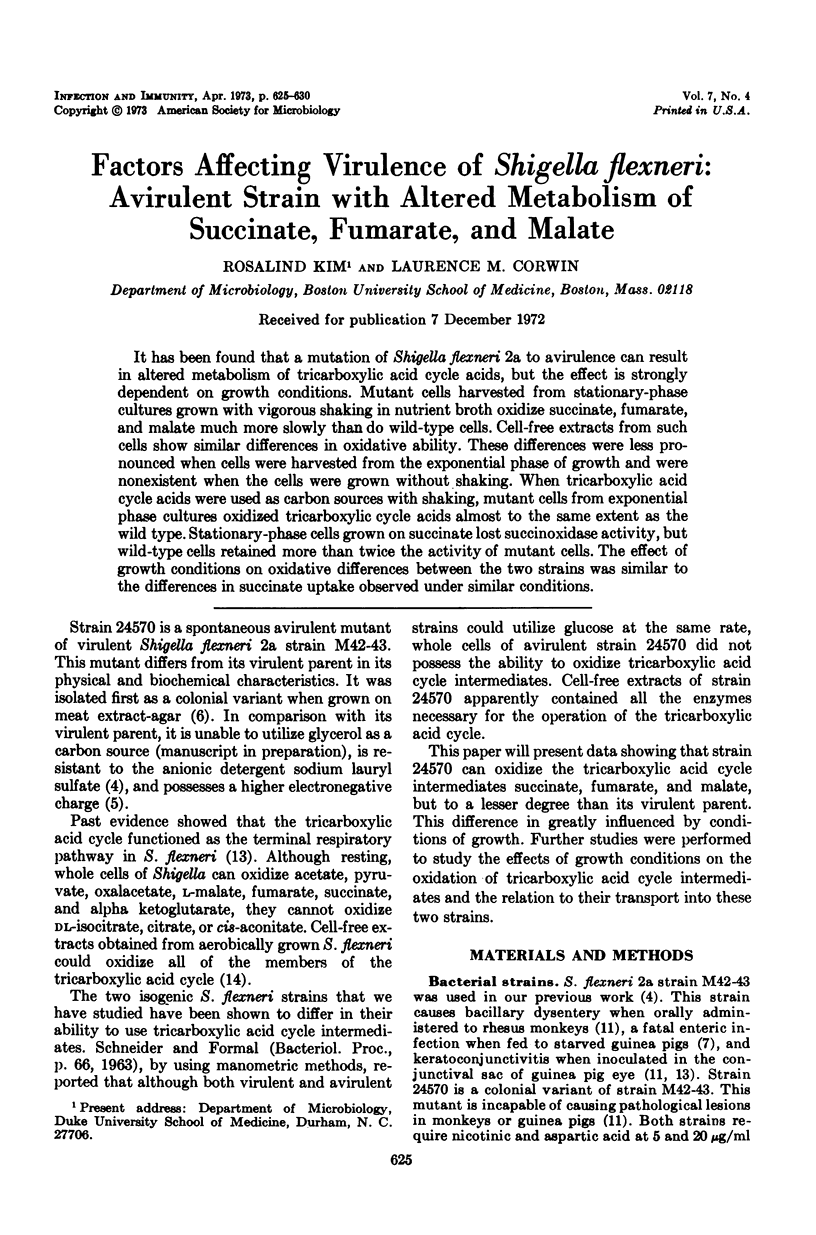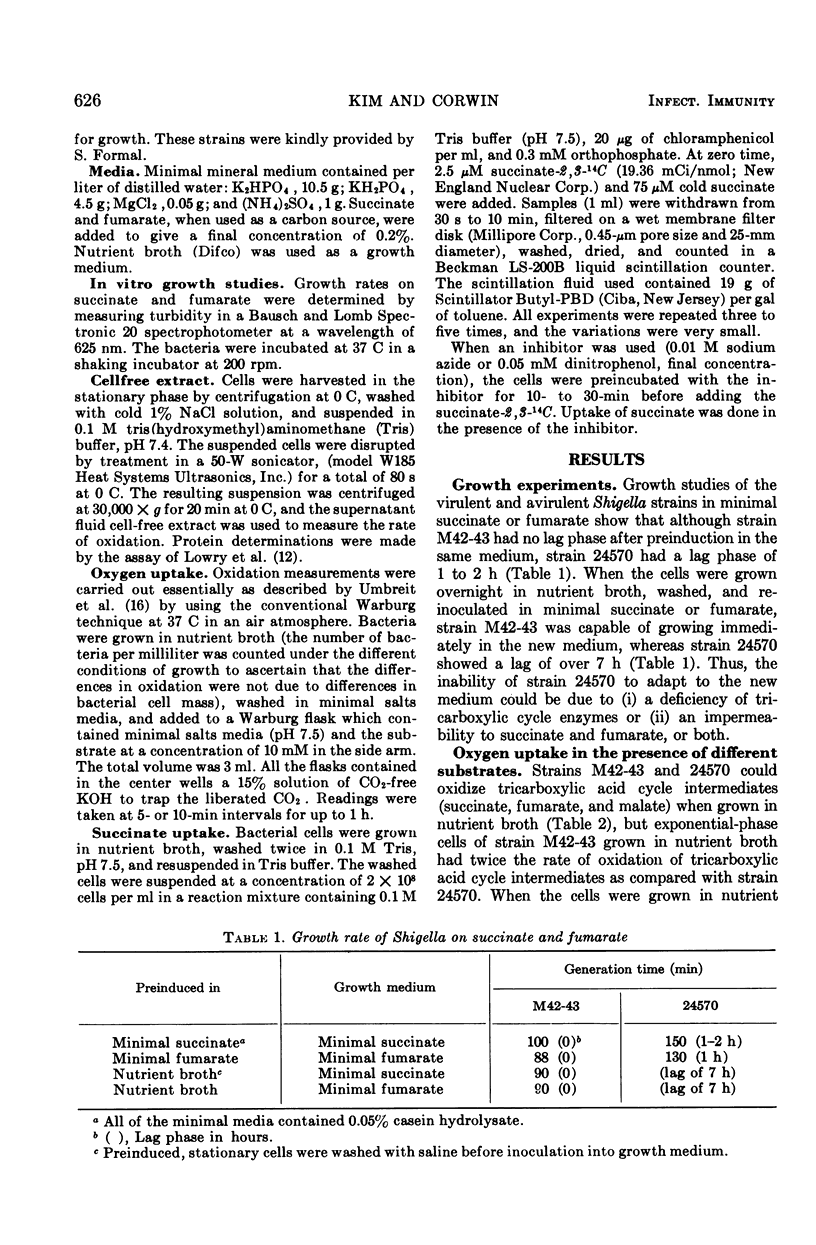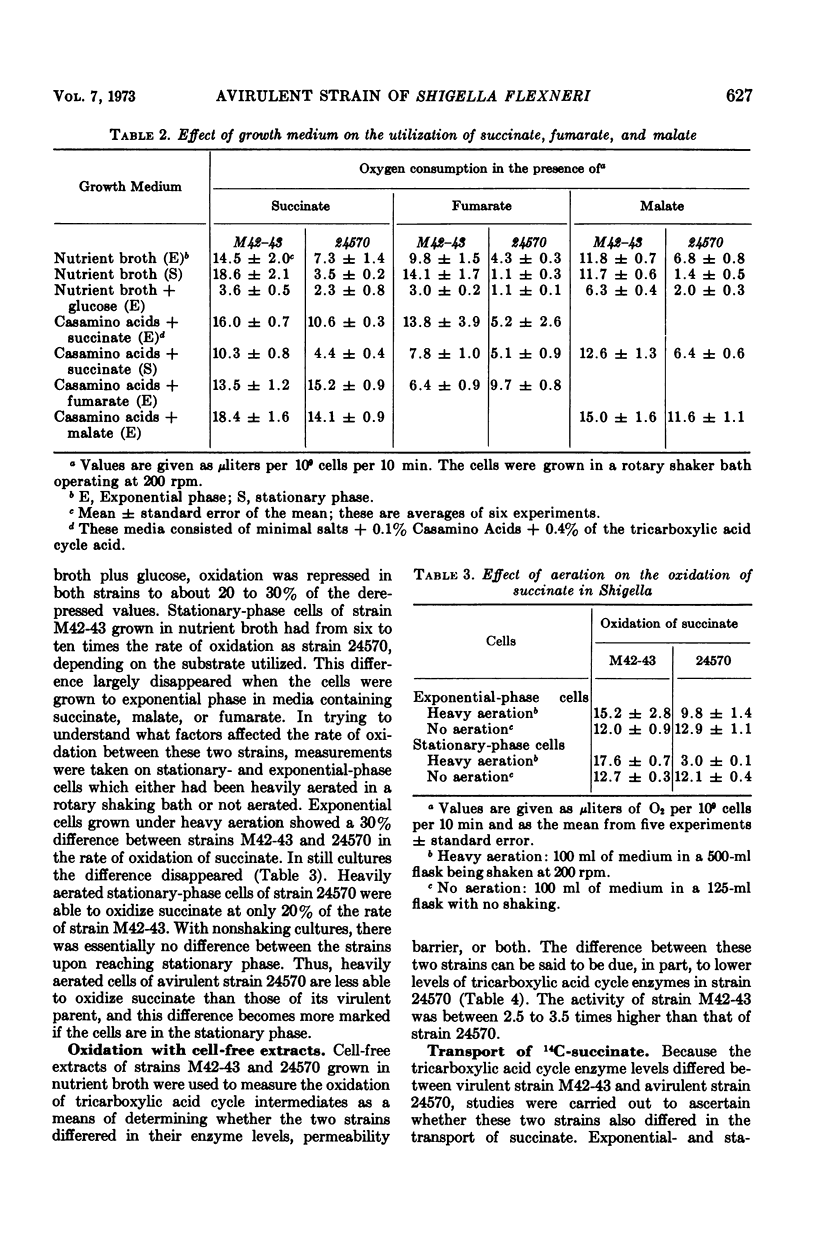Abstract
It has been found that a mutation of Shigella flexneri 2a to avirulence can result in altered metabolism of tricarboxylic acid cycle acids, but the effect is strongly dependent on growth conditions. Mutant cells harvested from stationary-phase cultures grown with vigorous shaking in nutrient broth oxidize succinate, fumarate, and malate much more slowly than do wild-type cells. Cell-free extracts from such cells show similar differences in oxidative ability. These differences were less pronounced when cells were harvested from the exponential phase of growth and were nonexistent when the cells were grown without shaking. When tricarboxylic acid cycle acids were used as carbon sources with shaking, mutant cells from exponential phase cultures oxidized tricarboxylic cycle acids almost to the same extent as the wild type. Stationary-phase cells grown on succinate lost succinoxidase activity, but wild-type cells retained more than twice the activity of mutant cells. The effect of growth conditions on oxidative differences between the two strains was similar to the differences in succinate uptake observed under similar conditions.
Full text
PDF





Selected References
These references are in PubMed. This may not be the complete list of references from this article.
- Brenner D. J., Fanning G. R., Skerman F. J., Falkow S. Polynucleotide sequence divergence among strains of Escherichia coli and closely related organisms. J Bacteriol. 1972 Mar;109(3):953–965. doi: 10.1128/jb.109.3.953-965.1972. [DOI] [PMC free article] [PubMed] [Google Scholar]
- Broda P. Ribonucleic acid synthesis and glutamate excretion in Escherichia coli. J Bacteriol. 1968 Nov;96(5):1528–1534. doi: 10.1128/jb.96.5.1528-1534.1968. [DOI] [PMC free article] [PubMed] [Google Scholar]
- Corwin L. M., Rothman S. W., Kim R., Talevi L. A. Mechanisms and genetics of resistance to sodium lauryl sulfate in strains of Shigella and Escherichia coli. Infect Immun. 1971 Sep;4(3):287–294. doi: 10.1128/iai.4.3.287-294.1971. [DOI] [PMC free article] [PubMed] [Google Scholar]
- Corwin L. M., Talevi L. A. Mutation in Shigella flexneri 2a resulting in increased electrophoretic mobility. Infect Immun. 1972 May;5(5):798–802. doi: 10.1128/iai.5.5.798-802.1972. [DOI] [PMC free article] [PubMed] [Google Scholar]
- FALKOW S., SCHNEIDER H., BARON L. S., FORMAL S. B. VIRULENCE OF ESCHERICHIA-SHIGELLA GENETIC HYBRIDS FOR THE GUINEA PIG. J Bacteriol. 1963 Dec;86:1251–1258. doi: 10.1128/jb.86.6.1251-1258.1963. [DOI] [PMC free article] [PubMed] [Google Scholar]
- FORMAL S. B., DAMMIN G. J., LABREC E. H., SCHNEIDER H. Experimental Shigella infections: characteristics of a fatal infection produced in guinea pigs. J Bacteriol. 1958 May;75(5):604–610. doi: 10.1128/jb.75.5.604-610.1958. [DOI] [PMC free article] [PubMed] [Google Scholar]
- HALPERN Y. S., EVEN-SHOSHAN A., ARTMAN M. EFFECT OF GLUCOSE ON THE UTILIZATION OF SUCCINATE AND THE ACTIVITY OF TRICARBOXYLIC ACID-CYCLE ENZYMES IN ESCHERICHIA COLI. Biochim Biophys Acta. 1964 Nov 8;93:228–236. doi: 10.1016/0304-4165(64)90370-8. [DOI] [PubMed] [Google Scholar]
- HERZBERG M., JAWAD M. J., PRATT D. CORRELATION OF SUCCINATE METABOLISM AND VIRULENCE IN SALMONELLA TYPHIMURIUM. J Bacteriol. 1965 Jan;89:185–192. doi: 10.1128/jb.89.1.185-192.1965. [DOI] [PMC free article] [PubMed] [Google Scholar]
- Kay W. W., Kornberg H. L. The uptake of C4-dicarboxylic acids by Escherichia coli. Eur J Biochem. 1971 Jan;18(2):274–281. doi: 10.1111/j.1432-1033.1971.tb01240.x. [DOI] [PubMed] [Google Scholar]
- LOWRY O. H., ROSEBROUGH N. J., FARR A. L., RANDALL R. J. Protein measurement with the Folin phenol reagent. J Biol Chem. 1951 Nov;193(1):265–275. [PubMed] [Google Scholar]
- Labrec E. H., Schneider H., Magnani T. J., Formal S. B. EPITHELIAL CELL PENETRATION AS AN ESSENTIAL STEP IN THE PATHOGENESIS OF BACILLARY DYSENTERY. J Bacteriol. 1964 Nov;88(5):1503–1518. doi: 10.1128/jb.88.5.1503-1518.1964. [DOI] [PMC free article] [PubMed] [Google Scholar]
- MACKEL D. C., LANGLEY L. F., VENICE L. A. The use of the guinea-pig conjunctivae as an experimental model for the study of virulence of Shigella organisms. Am J Hyg. 1961 Mar;73:219–223. doi: 10.1093/oxfordjournals.aje.a120179. [DOI] [PubMed] [Google Scholar]
- PAN S. F., YEE R., GEZON H. M. Studies on the metabolism of Shigella. I. The occurrence of a tricarboxylic acid cycle in Shigella flexneri. J Bacteriol. 1957 Mar;73(3):402–409. doi: 10.1128/jb.73.3.402-409.1957. [DOI] [PMC free article] [PubMed] [Google Scholar]
- Postma P. W., van Dam K. The inducible transport of DI- and tricarboxylic acid anions across the membrane of Azotobacter vinelandii. Biochim Biophys Acta. 1971 Dec 3;249(2):515–527. doi: 10.1016/0005-2736(71)90127-1. [DOI] [PubMed] [Google Scholar]


